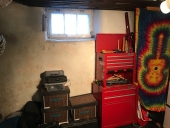posted 13 years ago
I have two things to point out about your overall design--
1) With all of the bends and convolution in your exhaust, the air is having to do an awful lot of work to get out the other end. You could probably dispense with one of those big secondary clean-outs and replace it with a regular elbow...would help a little. You're actually going to catch most of your ash in the first ash-pit since it's a vertical drop.
2) The other thing is that your modified design has gone away from a couple of key principles that are going to give you, not only better draft, but higher temps as well.
First of all, your burn chamber is not insulated. By only containing the point of combustion in steel that is exposed to the surrounding air, you are losing a lot of thermal energy that needs to be retained in order to get the really high temps that promote a clean, high-velocity burn-- BUT, just surrounding your stove in cob or masonry would not solve the issue and give you better draft because there is a larger issue...
You don't really have a heat riser and a heat exchange in your stove. While your design is elegant in its symmetry... by welding two steel channels together, all you are doing is forcing the exhaust through a large radiator before it has to make a long slog through the mass with the fire as the only draft engine. The point to having an insulated firebox and heat riser with an exposed radiant heat exchange is to create, in essence, a difference engine that is powerful enough to maintain a high-temp/high-velocity burn and force the exhaust through a large mass. It is the difference in temperature between the hot gases rising in the insulated chimney and then being cooled rapidly in the exchange barrel that gets the system moving. Having the rise and the drop share the same uninsulated steel wall doesn't give you much difference in temperature between the two and hence, not a very powerful difference engine. Now, if you had just welded up the feed tube, burn chamber and riser tube... encased that assembly in masonry/cob... ensured that the riser tube had at least 2" of insulation (bentonite and perlite mix is good)... and then put a 55 gal barrel on as an exchange... you'd have a much more powerful draft.
To compound the issue though, it looks as if your CSA is the same throughout your stove (8x8?) and then your exhaust is 6" diameter. Not only is your exhaust CSA smaller than your input, but your burn chamber should be a bit smaller than all other CSAs. The riser/exchange create the draft and a choke point at the burn chamber create the higher temps.
Without a complete redesign of the stove end, I don't think removing a clean out will do much good.
"It is a miracle that curiosity survives formal education." -- Albert Einstein























 1
1












 . The only drawback to this solution is that you are still relying on the heavy gauge 8x8 tube stock to be your radiant transfer, which is much less efficient than the thinner steel and larger surface area of the drums you see used in so many other designs-- but I think your lining idea might give you an adequate enough performance boost to merit implementing it and see what happens.
. The only drawback to this solution is that you are still relying on the heavy gauge 8x8 tube stock to be your radiant transfer, which is much less efficient than the thinner steel and larger surface area of the drums you see used in so many other designs-- but I think your lining idea might give you an adequate enough performance boost to merit implementing it and see what happens.
















































